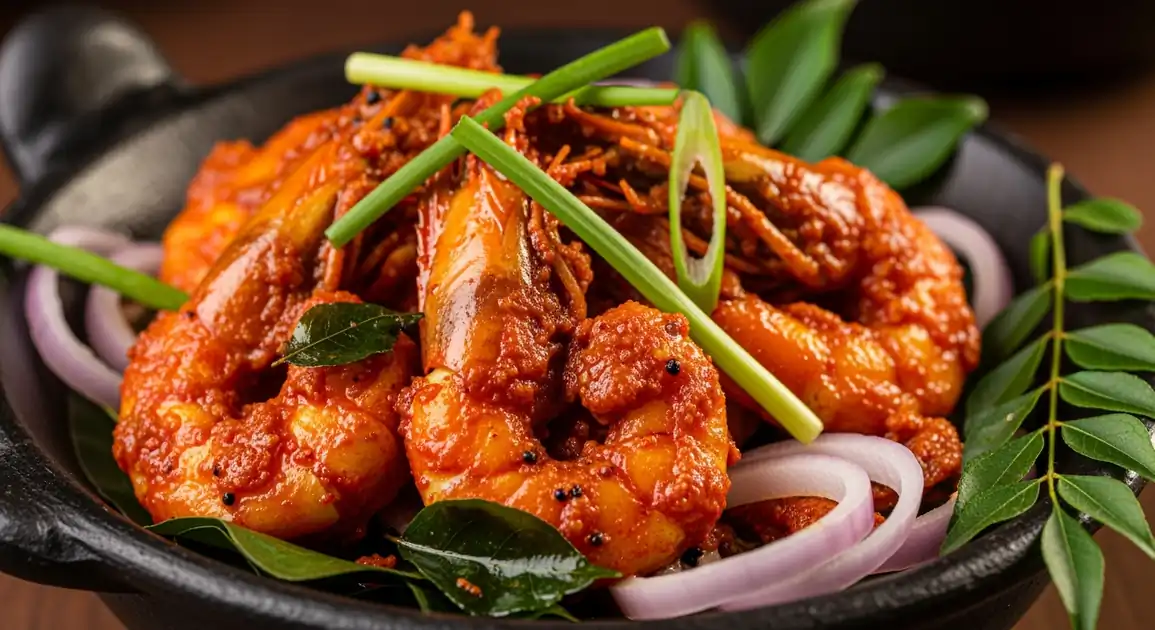Isso Devil (Deviled Prawns)
ඉස්සෝ ඩෙවිල්

Description
Isso Devil is widely available throughout Sri Lanka, particularly in coastal regions and urban centers. While traditionally a Tamil and northern Sri Lankan dish, it has gained popularity across the entire island, with regional variations reflecting local preferences for spice levels and ingredient availability. Sri Lankan Chinese restaurants, beachside eateries, and street food vendors in tourist areas commonly serve this dish.
Dietary Information
Serving information
Serving style
Typically served in a hot dish or metal plate as a shared appetizer or main dish. Often garnished with extra sliced green chilies, fresh curry leaves, and lime wedges. Usually eaten with rice, hoppers, or as a stand-alone dish with beer or other beverages.
Quick facts
Most restaurants serve lunch (12 PM - 3 PM) and dinner (6 PM - 10 PM). Street vendors and beachside stalls typically operate from late afternoon until late evening (4 PM - 11 PM).
Safety Tips
What to Look For
-
Prawns cooked thoroughly until opaque and curled
Properly cooked prawns change from translucent to opaque white with pink/red edges and naturally curl into a 'C' shape. This indicates they've reached a safe temperature to kill potential bacteria.
-
Fresh seafood storage on ice or refrigeration
Before cooking, prawns should be stored cold to prevent bacterial growth. Good vendors keep their seafood chilled until the moment of preparation.
-
Made-to-order preparation
Quality Isso Devil is cooked fresh upon ordering. Watch for vendors who prepare each dish individually rather than serving from a pre-made batch.
-
Clean, hot cooking equipment
A very hot wok or pan is essential for properly caramelizing the sauce and quickly cooking the prawns without making them rubbery. Clean equipment prevents cross-contamination.
-
Separate utensils for raw and cooked seafood
Responsible vendors use different utensils for handling raw prawns and the finished dish to prevent cross-contamination.
What to avoid
-
Gray or slimy-looking prawns
Discoloration or sliminess indicates spoilage. Fresh prawns should look firm and glossy with a clean sea smell.
-
Strong ammonia or fishy odor
Fresh seafood has a mild ocean scent. A strong ammonia or overly fishy smell suggests the prawns are past their prime.
-
Pre-cooked dishes sitting at ambient temperature
Isso Devil should be prepared fresh or kept properly hot. Seafood dishes sitting out can develop harmful bacteria, especially in warm climates.
-
Vendors with poor hygiene practices
Avoid vendors who handle money and food without washing hands, or who have visibly unclean cooking areas.
-
Undercooked prawns (translucent or mushy center)
Prawns must be fully cooked to a firm, opaque consistency throughout. Undercooked seafood poses significant food safety risks.
Price information
Price range
Budget tips
- Street food versions typically cost 600-1000 LKR for a good portion.
- Prices increase in tourist-oriented restaurants, especially in beach areas.
- Order a rice dish to share with Isso Devil to make a more economical meal.
- Inland areas may charge more due to transportation costs of fresh seafood.
- Small hotels (local restaurants) often offer better value than tourist establishments.
Value indicators
- Generous prawn size and quantity (at least 8-10 medium prawns per portion).
- Fresh ingredients evidenced by bright colors and aromatic smell.
- Made-to-order preparation rather than pre-cooked.
- Appropriate spice level according to your request.
- Proper thickness of sauce - should coat the prawns well, not be watery.
Where to Find This Dish
Coastal Areas
Beachfront restaurants and shacks offer fresh seafood devil dishes with ocean views.
Major beaches, Fishing harbors, Tourist promenades
Evening (6 PM - 10 PM)
Urban Centers
Sri Lankan Chinese restaurants in cities specialize in devil dishes including quality Isso Devil variations.
Shopping areas, Hotel zones, Entertainment districts
Dinner time (7 PM - 10 PM)
Markets and Food Streets
Night markets and food streets in tourist areas often feature local vendors with more authentic preparations.
Pettah Market (Colombo), Local night markets
Evening (6 PM - 9 PM)
Vendor Tips
- Ask where the prawns are sourced from - local catches are usually fresher.
- Observe if the vendor is busy - popular spots generally maintain better quality and freshness.
- Request to see the prawns before cooking if possible.
How to Order
Regional Variations
-
Ambulthiyal Isso Devil
(අමුල්තියල් ඉස්සෝ ඩෙවිල්)
A more sour variant using goraka (gamboge) or tamarind, giving a distinctly tangy profile characteristic of southern Sri Lankan cuisine.
-
Jaffna-Style Isso Devil
(යාපනේ ඉස්සෝ ඩෙවිල්)
Influenced by northern Sri Lankan cuisine, this version often includes more curry leaves, mustard seeds, and sometimes coconut milk for a deeper flavor profile.
-
Kochchi Isso Devil
(කොච්චි ඉස්සෝ ඩෙවිල්)
An extra-hot version featuring kochchi chilies (bird's eye chilies), significantly increasing the spice level for heat enthusiasts.
-
Isso Devil with Butter Sauce
(බටර් සෝස් සමඟ ඉස්සෝ ඩෙවිල්)
A richer variation incorporating butter into the sauce, creating a creamier texture popular in upscale restaurants.
-
Crispy Isso Devil
(ක්රිස්පි ඉස්සෝ ඩෙවිල්)
Prawns are coated in a thin layer of cornstarch before frying, creating an extra crispy exterior that holds the sauce well.
Cultural context
History
Isso Devil emerged from Sri Lanka's Chinese-influenced cuisine, which developed during colonial times and through Chinese merchant settlements. The 'devil' cooking method became popular in the mid-20th century, creating a distinctive style of preparation that applies Chinese stir-fry techniques to local ingredients and flavor profiles. The dish showcases Sri Lanka's culinary evolution as a trading hub where Eastern and Western flavors merged into unique creations that became integral to the island's coastal food culture.
Local significance
Isso Devil represents Sri Lanka's unique fusion cuisine that evolved from its trading history and multicultural influences. It showcases how the island adapted Chinese cooking methods to local ingredients and tastes.
Eating customs
- Served family-style for sharing.
- Eating with fingers is acceptable in casual settings, though spoons and forks are commonly provided.
- The sauce is considered a valuable part of the dish, often soaked up with rice or bread.
- Varying heat levels are accommodating to both locals and tourists.